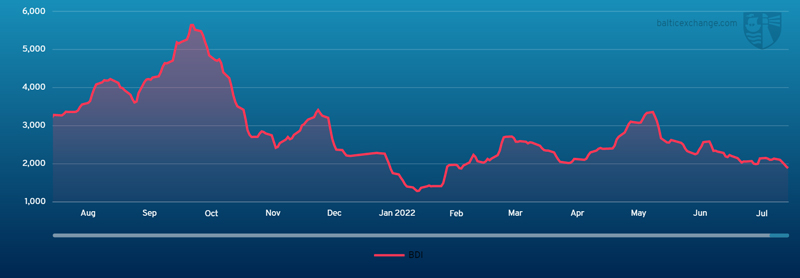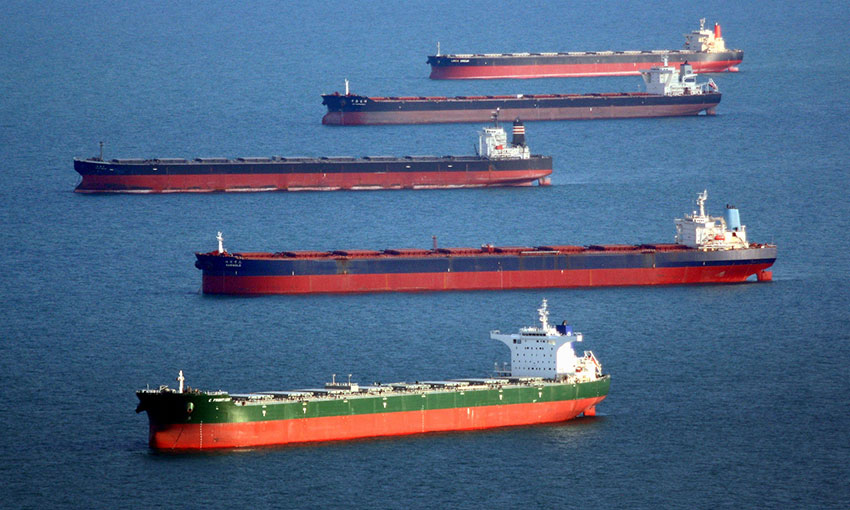THE Baltic Dry Index lost ground over the past week. The index started the week at 2114. The BDI lost ground from there, ending the week on 29 July at 1895.

Capesize
The Capesize market lost ground throughout the week with the average of the five time charter routes trending down from US$21,526 on Monday to US$17,255 on Friday.
The west Australia to Qingdao route lost US$1 over the week, with fixtures at US$9.75 at the close, whilst the Brazil to Qingdao trade fell below US$26 by Friday. Limited activity surfaced from the North Atlantic region as both fronthaul and Transatlantic cargoes appeared lacking. A Saldanha Bay to Rotterdam cargo was fixed below US$8 and an Australia to Ijmuiden cargo was fixed in the low/midUS$20s, both showing a much lower time charter equivalent value on the backhaul run. The route index eventually dropped into negative territory at -US$472. It was the first time since the end of February that the revised backhaul run fallen below 0 dollars. In contrast to the current negative sentiment, the peak of the year for the route was in May at over US$30,000 per day.
Panamax
Another softer week for the Panamax market as owners felt the recent pressure continue across all basins, some limited resistance shown in the North Atlantic but this was largely position led with fundamentals weaker overall. The P1A route hovered in the US$19,000s all week, although bids in the latter part of the week were heard to be closer to US$17,500. Activity ex EC South America was mostly flat with end August/early September arrival dates floating around the US$18,500 mark. Asia saw glimpses of fresh demand ex Australia and to a lesser degree NoPac, but rates drifted over the week with the tonnage count surpassing any demand. A rate of US$16,750 was concluded by an 81,000-dwt delivery Japan for a NoPac round trip midweek, but returned closer to mid US$15,000s for the same trade by the end of the week. Period activity was muted, however an 81,000-dwt delivery Vietnam achieved a shade over US$20,000 for six to eight months trading.
Ultramax/Supramax
For the most part, Atlantic activity was limited with the summer season in full flow and negative sentiment visible across both basins. A 63,000-dwt open in Cotonou for early August fixed via East Coast South America to Singapore-Japan range at US$24,000 and a 64,000-dwt fixed basis delivery East Coast South America to Singapore-Japan range at US$18,800, plus a ballast bonus of US$880,000. A 56,000-dwt fixed from SW Pass to the Continent with an intended cargo of Petcoke at US$29,000 whilst a 55,000-dwt fixed from South Spain to West Africa at US$21,000. In Asia a 58,000-dwt fixed from Singapore via Indonesia to China at US$18,000. A 63,000-dwt was rumoured to have been fixed for a trip from Japan to the US Gulf at US$22,000. On the period front a 63,000-dwt open prompt in Singapore fixed for four to six months at US$33,000 with the scrubber for Charterers benefit.
Handysize
With largely negative sentiment this week, levels in most regions declined. A 37,000-dwt was fixed from Recalada to the Western Mediterranean with an intended cargo of grains at US$32,000 and a 38,000-dwt fixed from Barcarena to Portugal at US$28,000, both earlier in the week before brokers said that levels had started to diminish due to lack of enquiry. A 40,000-dwt was rumoured to have been fixed from the US East coast to Aquaba at US$25,500. Asia was also in decline with a 38,000-dwt fixing from Singapore via Western Australia to South East Asia with an intended cargo of Alumina at US$22,000. A 32,000-dwt was fixed from Japan to South East Asia with an intended cargo of slag at US$16,500. A 38,000-dwt open in Kaohsiung end July fixing for two to three laden legs at US$27,250 and a 32,000-dwt open in Lanshan fixing for two to three laden legs redelivery Singapore-Japan range at US$20,750.
Clean
This week the Middle East Gulf LR2s have seen a small upturn, climbing 7.5 points to WS240 on TC1 then plateauing. The LR1s have been tested down reflected in the TC5 index dropping 28.92 points to WS256.79. We understand this has been from a glut of prompt available tonnage, amongst other factors.
The MRs of TC17 have also taken a downturn, after peaking at WS500 this time last week they have lost 43.34 points systematically over the last few days to settle at WS455.83 at time of writing. In the West, the LR2s of TC15 have ticked up again this week just climbing over the US$4 million mark seemingly sentiment driven with this run still to be tested.
On TC16 the LR1s have again been stable all week in the mid WS220s and still returning US$33,000 per day TCE round-trip.
On the UK-Continent, MR activity has been in full swing this week and subsequently freight levels have popped up. TC2 and TC19 have both risen 65 points across the last few days with TC2 now marked at WS336.67 and TC19 pegged at WS345.
The USG MR market has continued its charge from last week. Available and solid itinerary vessels are in short supply and TC14 has jumped up again to WS325 (+WS100) and TC18 has similarly risen WS85.84 to WS414.17. Most notably this has taken the TC18 run over the US$50,000 per day round-trip TCE. The MRA TCE jumped from 37,886 to 60,395.
On the Handymax cross Mediterranean, freight levels bottomed out for TC6 at WS215 mid-week and have now taken a small upturn (+WS5.13) to end up at WS221.88 (US$24,500 per day round-trip TCE).
In the Baltic, TC9 has continued along at the WS500-WS505 mark this week with the round-trip TCE still also holding at around US$60,000 per day.
VLCC
VLCC rates peaked at the end of last week – steadily and slowly easing this week – however, this is likely in reaction to falling bunker prices as earnings have edged higher. For 270,000mt Middle East Gulf/China, rates lost 2.5 points to WS59 (a round trip TCE of US$9,100 per day, having been just shy of US$9,000 a week ago), while the rate for 280,000mt Middle East Gulf/USG (via Cape of Good Hope) slipped a single point to WS34.5. In the Atlantic, rates for 260,000mt West Africa/China slipped 2.5 points to around the WS60 level (US$11,100 per day round-trip TCE, up from US$10,800 last week) and 270,000mt US Gulf/China shed US$37,500 to US$7.44 million (showing a round trip TCE of US$10,600 per day, improving from US$7,600 a week ago).
Suezmax
Rates for 135,000mt Black Sea/Augusta eased 1.5 points to WS206 (a round-trip TCE of about US$86,900 per day). For the 130,000mt Nigeria/UKC trip rates have been reduced by three points to WS137 (a round-trip TCE of US$35,000 per day). In the Middle East the rate for 140,000mt Basra/West Mediterranean fell four points to about the WS78/79 level.
Aframax
The Mediterranean market improved very slightly with the rate for 80,000mt Ceyhan/West Mediterranean up a point to WS274 (a round-trip TCE of US$80,000 per day). In Northern Europe the market continued its downward spiral with the rate for 80,000mt Hound Point/UK Continent losing 14 points to about WS177 (a daily round trip TCE of US$43,700). For the 100,000mt Primorsk/UK Continent route rates fell 11.5 points to WS218 (a round trip TCE of US$67,600 per day).
Across the Atlantic, the market fell heavily. For 70,000mt EC Mexico/US Gulf rates collapsed 76.5 points to WS223 (a round-trip TCE of US$39,700 per day), while in the 70,000mt Caribbean/US Gulf market, the rate was pared back 38 points to a fraction below WS210 (a round-trip TCE of about US$31,600). For the Transatlantic trip of 70,000mt US Gulf/UK Continent, the rate has also dropped 37 points to the WS202.5 level (US$30,300 per day round-tip TCE).

